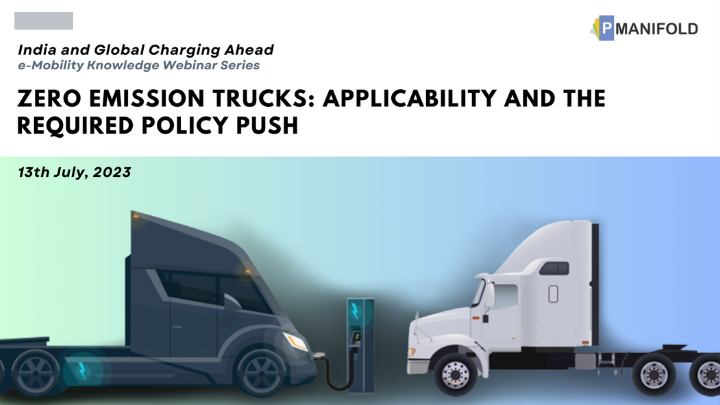India is the world’s sixth-largest commercial vehicle market by sales volume and the third-largest manufacturer, with more than 4.6 billion tonnes of freight transported annually. Domestic commercial vehicle sales have grown at a compound annual growth rate (CAGR) of 7% between 2014 and 2021. Medium and Heavy-duty Truck (MHDT) segment, which includes vehicles with a GVW greater than 3.5 T, accounted for about 45% of total commercial vehicle sales in 2021. While the MHDT sales represent only 5% of the total automotive market, they contribute approximately 45% of on-road emissions, with the MHDT segment estimated to contribute as high as 70% of criteria pollutants, especially NOx emissions. Therefore, addressing
emissions from heavy freight transport is crucial for India’s clean road transport transition, particularly in the context of achieving its Net Zero Goal by 2070.
The prospects for electrifying trucking are improving. Global experiences in China, Europe, and California have witnessed sales of e-Trucks, driven by government support, technology development, and increasing model availability, albeit from a small base. In the light and intermediate truck segment, electrification is expected to achieve total cost of ownership (TCO) parity with diesel trucks by 2024, and in certain key applications, MHDT are expected to attain TCO parity within the same time frame.
Governments can play a vital role in accelerating the deployment of e-Trucks by introducing policies that support economies of scale, leading to lowering of purchase costs. This includes purchase subsidies, bulk procurement like India’s bus segment, and early planning and investments in charging and grid infrastructure. Currently, India’s FAME-II scheme does not provide incentives for e-MHDT, nor does it include private buses. Furthermore, while many states have EV policies, they lack a specific focus on freight decarbonisation.
In March 2023, Technical Roadmap on Deployment of Zero-Emission Trucking in India prepared by Principal Scientific Adviser has been submitted to the Govt. of India. This milestone roadmap identifies various technical actions for ZET implementation and broadly outline pathways to ZET adoption in India, including policy, financing, business models, charging, technology and manufacturing, providing a solid foundation for future developments, research, and collaborative efforts in the field of e-Mobility.
As the demand side creates market signals for e-Trucks, it is crucial to understand the perspective of MHDT manufacturers regarding e-Truck technology development, costs, product availability, market readiness, and the status and challenges to achieve targets of Technical Roadmap on ZET. With a largely fragmented trucking industry, clarity on the distinct and intersecting roles and market opportunities of fleet players, MHDT OEMs, and infrastructure providers will be key in driving the transition to Zero Emission Trucks (ZETs).
Key discussion points:
1) Policy and Technological Roadmap for shifting the Indian Trucking sector from ICE to Zero-emission technologies
2) Cost Economics and financial aspects associated with the adoption and operation of ZETs
3) Collaboration between demand and supply sides on a unified platform to explore prospects for e-Truck pilots and initiatives
4) Market Needs and Growth Opportunities for strong domestic ZET market, providing scale for manufacturing and exports
5) Discussing Technical Roadmap for Zero-emission Trucking by PSA and the Need for a Supporting Ecosystem and Measures
Panellists:
- Karthick Athmanathan – PSA fellow- ZET Expert and Professor of Practice, IIT Madras
- S.A Sundaresan – Head, New Technologies, Ashok Leyland
- Anand Mimani – CEO, GreenLine


